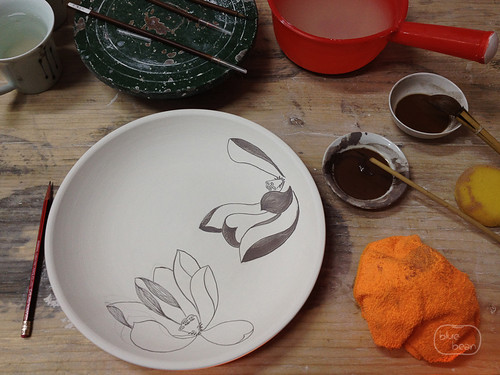My first trip to the porcelain capital of the world opened my eyes to the rich history of ceramics in China. From early on, the Chinese produced ceramics in an “assembly line” sort of fashion, with division of labor whereas various people were responsible for a different part of the process. As a result, a ceramics worker would become expert at his or her step in the production line. For example, a thrower would only focus on throwing the pots, which would then be passed on to the trimmer. The next step was decoration, which would be done by a painter or a carver.
On that first trip to Jingdezhen, my group had the opportunity to learn traditional “blue flower” painting from a qinghua painter with over 20 years’ experience — if interested, you can read the post about what we learned. After returning home and applying the techniques to my work, I realized that I was drawn to this particular form of decoration especially as it intersected with my Western aesthetics.
Upon the encouragement of my hubby and other supportive friends, I decided to go back to Jingdezhen on my own for a very brief residency so that I could learn more as well as spend some time practicing and producing work.
This time around, I had a private lesson with a younger qinghua artist who had a personal interest in both ancient techniques as well as modern applications. He not only painted qinghua, he also collected antique qinghua shards. As such, I had a chance to explore various styles of painting in addition to the more traditional method.

Wanting to make the most of my stay, I also took lessons in overglaze painting and carving. It was rather humbling to realize that I was learning techniques first practiced centuries ago to produce imperial ceramics ware.
Leaving Jingdezhen, I was left with the feeling that there is much, much more to learn. Even amid rapid modernization, the thread of history can be sensed running beneath the ever-changing cityscape of new constructions. The porcelain city is certainly one sitting atop many layers, not only of old broken pieces of pottery from another era, but also of various ancient techniques that have been passed on through time.
| CATEGORY: Insider | |
|
POSTED by blue bean |
December 20, 2012 |








Leave a Reply